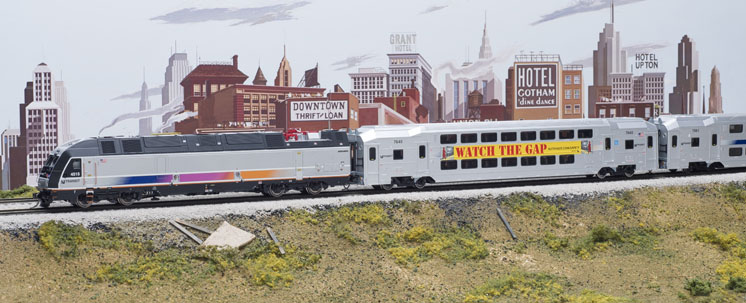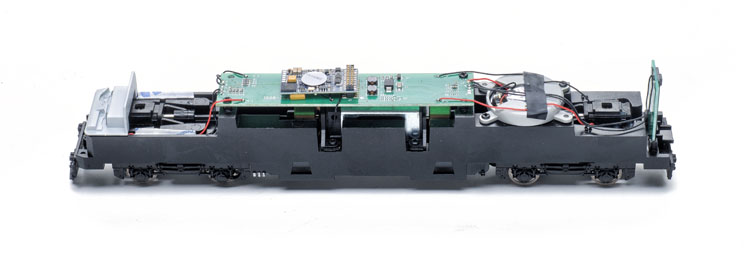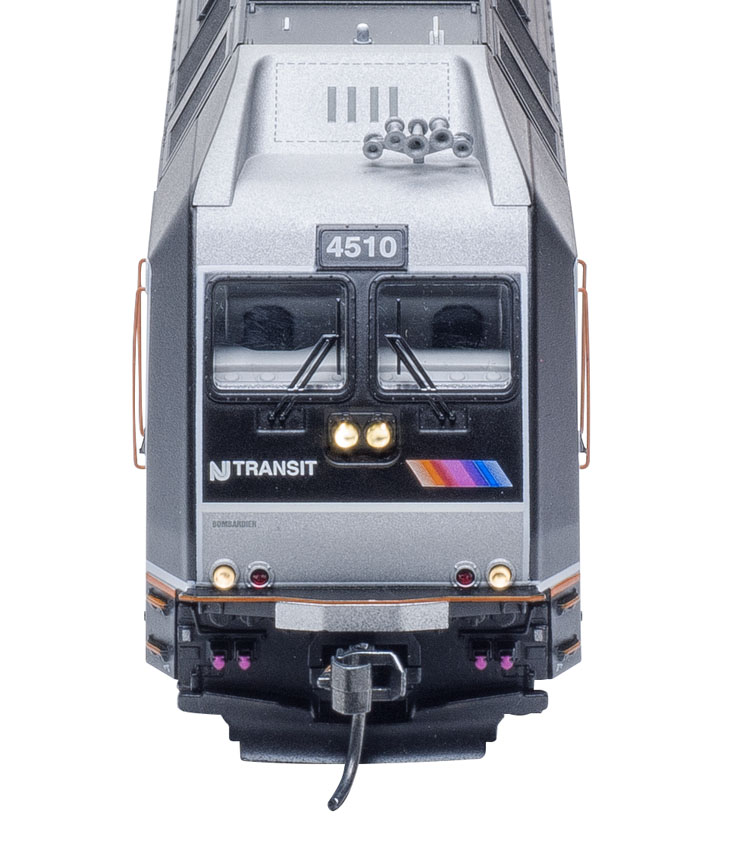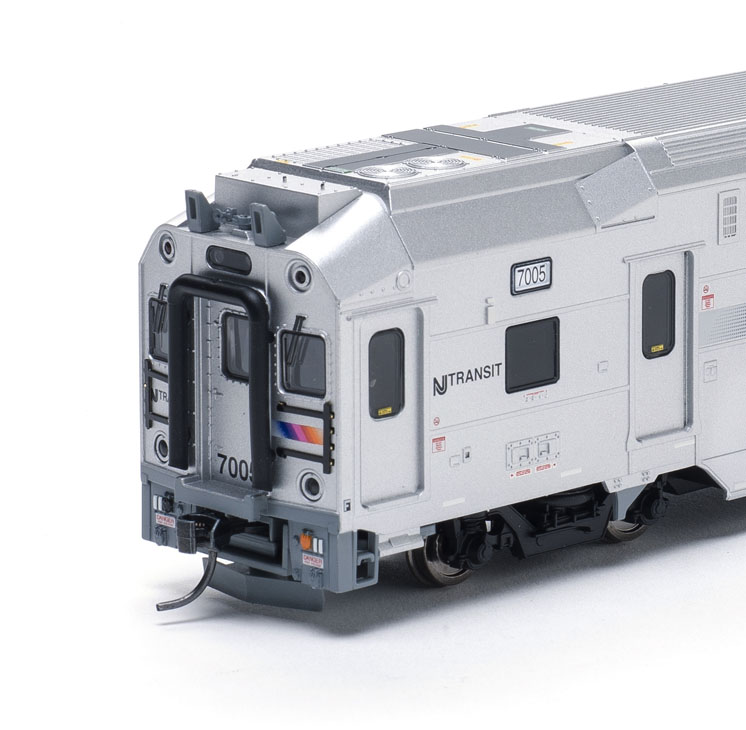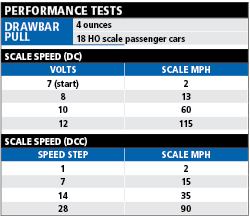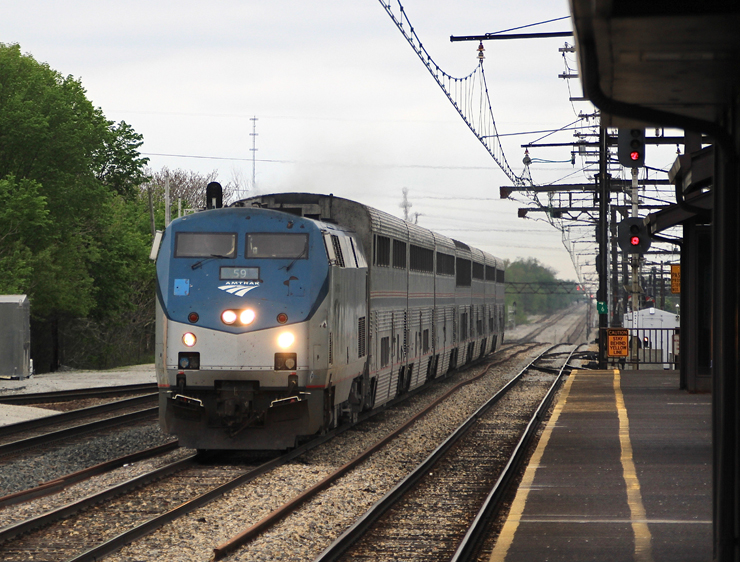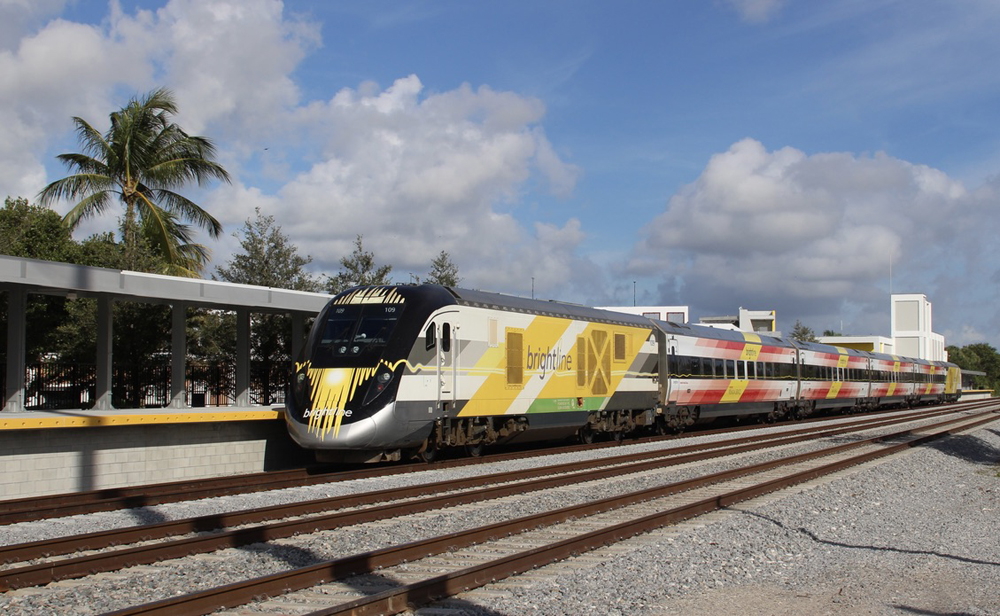Over the last several years the sleek Bombardier ALP-45DP locomotive and matching multilevel trailers and cab cars have become a common sight for northern New Jersey-area commuters. Thanks to Atlas, fans of modern mass transit can add accurate models of these state-of-the-art trains to their HO scale fleets. Our product review samples included an ALP-45DP locomotive that came factory-equipped with a dual-mode ESU LokSound Select decoder.
Prototype. Entering revenue service in 2012, the Bombardier ALP-45DP provides NJ Transit passengers a one-seat ride between New York City’s electrified territory into Pennsylvania Station and NJT’s various diesel-only lines. Previously, passengers had to change trains or wait while crews swapped an electric locomotive for a diesel-electric or vice versa.
The ALP-45DP (American Locomotive Passenger, 4 axle, power class 5, Dual Power) can operate as either a straight electric or diesel-electric locomotive. In electric mode a pantograph collects alternating current from overhead wires. In diesel-electric mode, twin Caterpillar diesel engines generate electricity for the traction motors. Switching between modes takes less than 2 minutes.
The NJ Transit ALP-45DP locomotives operate in push-pull service using multilevel trailers and cab cars also built by Bombardier. Agence Métropolitaine de Transport, the transit agency that serves the greater Montreal area, also uses Bombardier ALP-45DPs and cars.
The Atlas ALP-45DP. The main dimensions of the Atlas model match those of the prototype, including the scale 44″-diameter wheels. The well-defined molded details, including grills and fuel and sand filler hatches are properly placed according to prototype photos.
There’s clear plastic glazing in all the windows. The windshields reveal a cab interior with simplified control panel detail molded in front of where the engineer would sit. The seat backs are molded details painted black. Those who want to add a train crew will need to use half figures (with no legs) to fit the space.
The non-operating pantograph is made of plastic with a metal shoe. A latch holds the sprung pantograph in the down position. When I flipped the latch with my fingernail, the pantograph sprang to the raised position.
The model features many other separate, factory-applied detail parts, including windshield wipers, air horn, rooftop antenna, and cab door handrails.
The front handrails and grab irons are user-installed, as shown in a printed instruction sheet. The included drilling template snaps on the model’s nose to ensure that the no. 80 holes that I had to drill were properly positioned. However, modelers should ignore the hole marked “06” on the top of the template; it has no corresponding part. Although the installation isn’t too difficult, it’s tedious. I would have preferred that all the details be factory installed.
The locomotive’s paint scheme matches its prototype. The violet and orange stripe along the sides is especially well done. I think that painting the model silver rather than plating it was a wise choice by Atlas to capture the look of the prototype’s aluminum body.
Mechanism. Removing the press-fit locomotive body shell reveals a die-cast metal chassis. Driveshafts connect the dual-flywheel-equipped motor to the truck-mounted gearboxes. The main printed circuit (PC) board is attached to the frame above the motor.
The ESU LokSound Select decoder is plugged into a 21-pin plug atop the PC board. A well enclosed 28mm round speaker provides clear, undistorted sounds even at full volume.
The model’s heavy frame and all-wheel-drive mechanism contribute to its 4 ounces of drawbar pull. The locomotive has more than enough power to haul a typical eight-car consist.
DCC and DC performance. On our DCC test track, the ALP-45DP started moving at 2 scale mph and attained a 90 scale mph top speed at step 28. The speed curve, acceleration and deceleration momentum, and every other aspect of the decoder can be fine-tuned using configuration variables (CVs). An extensive programming manual is available as a free download on the Atlas website.
From the Atlas website I also downloaded the function list specific to the ALP-45DP. In addition to triggering the bell, horn, and lights, I could use my DCC throttle to switch between diesel and electric mode and turn on the air conditioner sounds. There are also coupler clank, sanding valve, and brake sound effects.
The engine sounds, bell, and horn are spot-on when compared to prototype videos. The distinctive sound of the modified Nathan K5LA air horn is especially noteworthy.
Like other sound-equipped models, the LokSound equipped ALP-45DP took a lot of power to start moving on our DC test track. At 6V the lights turned on and diesel engine sounds started. At 7V the model rolled smoothly at 2 scale mph and accelerated to a 115 scale mph top speed at 12V. The locomotive headlights and markers operate automatically according to the direction of travel.
Other sound effects can be triggered on DC layouts with an analog sound programmer, such as the MRC Tech 6. For those with access to a DCC system or a Tech 6, changing the value of CV13 toggles between diesel (160) and electric (40) prime mover sounds.
Multilevel cars. The trailers and cab car match the dimensions of Bombardier builder’s diagrams. The window arrangements, placement of details, and paint schemes match prototype photos.
All the models feature clear printing and properly placed warning stencils. The cars’ silver paint and striping also perfectly matches the locomotive’s decoration. Cars are available in multiple road numbers, including those with special safety slogan paint schemes, such as Watch The Gap and Always Expect A Train.
When the prototype cars are coupled, the diaphragms should touch. When the models are coupled, there is a scale 18″ gap between the diaphragms of the adjoining cars. This extra space along with sprung draft gear boxes is necessary for the cars to negotiate 22″ minimum radius curves.
The body shells are press-fit and easy to remove, which makes it easy to add passenger figures. Both the top and bottom levels are one-piece gray plastic castings. The seat detail is well defined with correctly shaped seat backs and arms. The cab car includes an operator’s compartment with a seat and control panel.
The top and bottom levels of each car feature overhead lighting provided by surface-mount light-emitting diodes (LEDs) attached to printed circuit boards. The lighting board for the bottom level is mounted on the floor of the top level. All-wheel electrical pickup on each car kept the lights shining steadily even as I ran the train through a yard ladder and over crossings. The interior lights operate on DC and DCC layouts.
The cab car also features operating headlights, ditch lights, and markers. On DC layouts these lights operate according to direction. On a DCC layout the lights are always on, unless a decoder is installed.
There’s a 21-pin DCC plug on the upper PC board of the cab car. A small jumper board must be removed before installing a decoder, such as a 21-pin ESU LokSound Select. ESU has released a sound file specifically for the cab car. For more information, click on Downloads at www.esu.eu/en/start. Note that Lokprogrammer software is required for those who want to use the file on a LokSound Select decoder.
Sound holes are arranged in a 5⁄16″ x 1″ rectangle on the car floor behind the operators cab. This would be an ideal application for a compact “sugar cube” speaker. Soldering connections for the speaker wires, marked LS+ and LS-, are located above the sound holes on the upper level PC board.
The Atlas ALP45-DP with matching trailers and cab car would be the highlight of a modern, commuter-themed model railroad.
Price (multiple road numbers available): Locomotive: $279.95 (DCC sound), $169.95 (DC, no sound)
Cab car: $99.95
Trailer (versions available with or
without toilet): $84.95
Trailer with safety slogan: 89.95
Three-pack (includes cab car, trailer
with toilet, trailer without toilet): $269.85; Three-pack (includes locomotive (DC), trailer, and cab car): 354.85
Manufacturer
Atlas Model Railroad Co.
378 Florence Ave.
Hillside, NJ 07205
www.atlasrr.com
Era: 2012 to present day
Road name: NJ Transit, Agence métropolitaine de transport (AMT), Bombardier demonstrator (locomotive only)
Locomotive features







Trailer features





Additional cab car features









